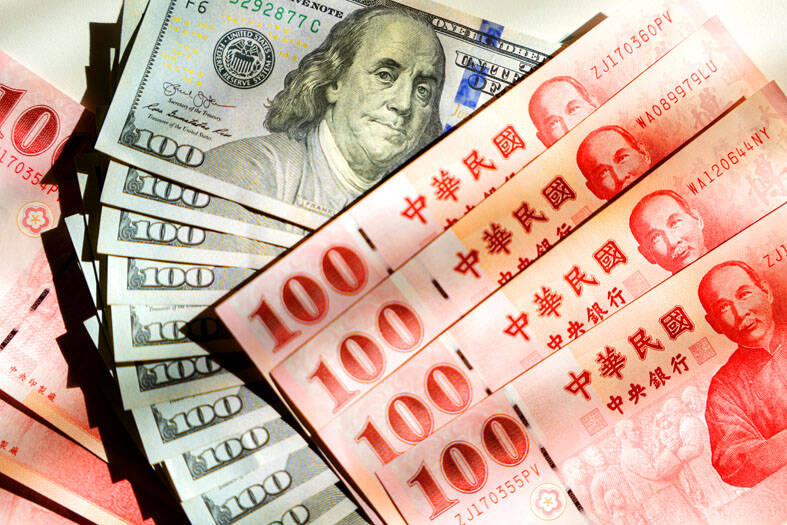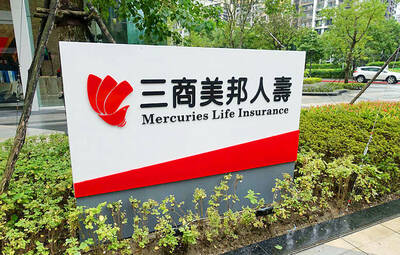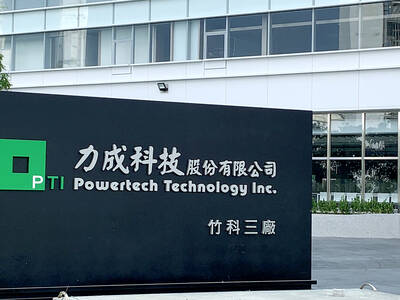The New Taiwan dollar yesterday extended its losing streak to a fifth straight session, closing at NT$29.719 against the US dollar, down NT$0.13 from the previous day, as broad US dollar strength and lingering trade uncertainties weighed on non-US dollar currencies, traders said.
The NT dollar depreciated NT$0.357, or 1.21 percent, against the greenback over the past five trading days, central bank data showed.
Turnover at Taipei Forex Inc fell to US$878 million, reflecting subdued investor activity as markets await Washington’s tariff rate on Taiwan.

Photo: CNA
“The US dollar index has shown significant strength in recent sessions, putting pressure on non-dollar currencies,” a Taipei-based currency trader said. “With Taiwan’s tariff arrangement [with the US] still unresolved, many investors prefer to stay on the sidelines.”
Washington has concluded trade agreements with economies including the EU, Japan, Vietnam and Indonesia, featuring lower-than-expected tariff rates — moves that have helped stabilize global trade sentiment and supported the greenback, the trader added.
The shift marks a twist in Washington’s trade posture. Initially viewed as confrontational, recent actions suggest a more measured and pragmatic strategy, the trader said.
The extension of the US-China trade truce beyond its Aug. 12 deadline — following inconclusive talks in Stockholm on Tuesday — further signals Washington’s intent to avoid immediate escalation and buy time for further negotiations, they said.
However, the outcome of Taiwan’s own discussions with the US remains unclear, keeping investors cautious.
“If the US sets the tariff rate above 20 percent for Taiwan, the NT dollar could face further downside risks,” another trader said. “A lower-than-expected rate, on the other hand, could ease pressure and allow for a modest rebound.”
In the meantime, the central bank has allowed the NT dollar to move in line with broader market forces under its “willow theory” approach to exchange rate management, a third trader said.
First articulated by then-central bank governor Perng Fai-nan (彭淮南) in 2005 and upheld by central bank Governor Yang Chin-long (楊金龍), the strategy favors flexibility and selective intervention — guiding the currency like a willow bending with the wind — rather than defending a fixed level.
A weaker NT dollar should offer local exporters some relief, easing concerns over eroding competitiveness and mitigating foreign exchange losses, the third trader said.
Meanwhile, attention is turning to global monetary policy.
The US Federal Reserve and the Bank of Japan are scheduled to hold policy meetings this week, with markets broadly expecting both to leave interest rates unchanged as they gauge the effects of new US tariffs.

Mercuries Life Insurance Co (三商美邦人壽) shares surged to a seven-month high this week after local media reported that E.Sun Financial Holding Co (玉山金控) had outbid CTBC Financial Holding Co (中信金控) in the financially strained insurer’s ongoing sale process. Shares of the mid-sized life insurer climbed 5.8 percent this week to NT$6.72, extending a nearly 18 percent rally over the past month, as investors bet on the likelihood of an impending takeover. The final round of bidding closed on Thursday, marking a critical step in the 32-year-old insurer’s search for a buyer after years of struggling to meet capital adequacy requirements. Local media reports

US sports leagues rushed to get in on the multi-billion US dollar bonanza of legalized betting, but the arrest of an National Basketball Association (NBA) coach and player in two sprawling US federal investigations show the potential cost of partnering with the gambling industry. Portland Trail Blazers coach Chauncey Billups, a former Detroit Pistons star and an NBA Hall of Famer, was arrested for his alleged role in rigged illegal poker games that prosecutors say were tied to Mafia crime families. Miami Heat guard Terry Rozier was charged with manipulating his play for the benefit of bettors and former NBA player and

The DBS Foundation yesterday announced the launch of two flagship programs, “Silver Motion” and “Happier Caregiver, Healthier Seniors,” in partnership with CCILU Ltd, Hondao Senior Citizens’ Welfare Foundation and the Garden of Hope Foundation to help Taiwan face the challenges of a rapidly aging population. The foundation said it would invest S$4.91 million (US$3.8 million) over three years to foster inclusion and resilience in an aging society. “Aging may bring challenges, but it also brings opportunities. With many Asian markets rapidly becoming super-aged, the DBS Foundation is working with a regional ecosystem of like-minded partners across the private, public and people sectors

BREAKTHROUGH TECH: Powertech expects its fan-out PLP system to become mainstream, saying it can offer three-times greater production throughput Chip packaging service provider Powertech Technology Inc (力成科技) plans to more than double its capital expenditures next year to more than NT$40 billion (US$1.31 billion) as demand for its new panel-level packaging (PLP) technology, primarily used in chips for artificial intelligence (AI) applications, has greatly exceeded what it can supply. A significant portion of the budget, about US$1 billion, would be earmarked for fan-out PLP technology, Powertech told investors yesterday. Its heavy investment in fan-out PLP technology over the past 10 years is expected to bear fruit in 2027 after the technology enters volume production, it said, adding that the tech would